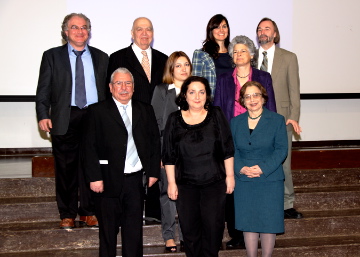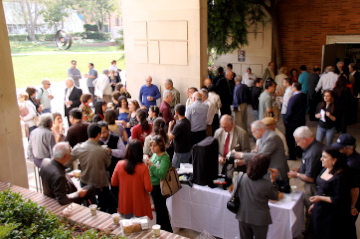
 ?The Armenian Communities of Asia Minor,? the eighteenth international conference in the UCLA series on historic Armenian provinces, cities, and communities took place before a large and enthusiastic audience at UCLA?s Rolfe Hall on Saturday, March 20, 2010.
?The Armenian Communities of Asia Minor,? the eighteenth international conference in the UCLA series on historic Armenian provinces, cities, and communities took place before a large and enthusiastic audience at UCLA?s Rolfe Hall on Saturday, March 20, 2010.
The Program
This final conference in the series focused on the small but vibrant Armenian communities of Asia Minor extending from the Dardanelles and Sea of Marmara inland to Kastamoni and Konia. Speakers presented the history as well as the social, economic, and cultural life of these communities and their final tragic years. Among the many small Armenian communities throughout Asia Minor, particular attention was given to Adabazar, Bardizag, Ismid, Armash, Bursa, Banderma, Bolu, Eskishehir, Sivrihisar, Kutahia, and Konia. After an overview of these communities, their schools, churches, and cultural establishments, by AEF Chair and conference organizer Richard Hovannisian, Ms. Dawn Miskjian MacKeen, a Los Angeles writer, used her grandfather's handwritten journal to trace life in Adabazar and the deportation routes to the desert, which she personally followed in preparing her forthcoming book on the subject.
Mr. Ara Melikian, an independent scholar from England who has translated several Armenian classics to English, took the audience back to the native town of his paternal relatives, Bardizag, with its rich agricultural and silk production and its distinct Armenian dialect. Dr. Barbara Merguerian of AIWA and a former editor of the Armenian Mirror-Spectator discussed the schools of Adabazar and Bardizag which were organized and sponsored by American missionary groups, the work of Miss Elizabeth Farnsworth, and the internal dynamics within the Armenian community and within the Armenian Evangelical denomination itself. The lectures on Adabazar and Bardizag were enhanced with visual illustrations.
Mrs. Vartouchka Samuelian of the Oriental Language Institute in Paris (INALCO) has done extensive fieldwork on Armenian dialects and spoke on the information gathered from the last speakers of the Bolu dialect. Although Bolu is not distant from Constantinople, the people there spoke an Eastern Armenian dialect, which they had preserved despite the passage of several centuries since their arrival in Asia Minor from the Plain of Ararat and Nakhichevan.
UCLA Narekatsi Professor Peter Cowe traced the existence of the Armenian community of Konia during the period of the Seljuks and the Sultanate of Iconium, demonstrating an important medieval Armenian presence in this key junction between Greater Armenia and Asia Minor, on the one hand, and Cilicia on the other.
 Two conference participants traveled from Armenia to present the results of their research. Dr. Hasmik Khalapyan of Yerevan State University examined the pioneering role of Armenians in the establishment and development of the theater in Asia Minor and the Armenian community of Rodosto/Tekirdagh on the European side of the Straits. Musicologist Arpi Vardumyan, senior researcher in the Mashtots Matenadaran in Yerevan, assessed the musical legacy of the Armenian community of Kutahia, also famed for its beautiful tiles. She focused particularly on the family of world-renowned composer, ethnomusicologist, and choir director Komitas (Gomidas) Vardapet.
Two conference participants traveled from Armenia to present the results of their research. Dr. Hasmik Khalapyan of Yerevan State University examined the pioneering role of Armenians in the establishment and development of the theater in Asia Minor and the Armenian community of Rodosto/Tekirdagh on the European side of the Straits. Musicologist Arpi Vardumyan, senior researcher in the Mashtots Matenadaran in Yerevan, assessed the musical legacy of the Armenian community of Kutahia, also famed for its beautiful tiles. She focused particularly on the family of world-renowned composer, ethnomusicologist, and choir director Komitas (Gomidas) Vardapet.
As in nearly all conferences in this series, the story of each community ends violently in the period between 1915 and 1923. The isolated communities of Asia Minor were no exception and suffered the same fate as those in the historic homelands of Western Armenia and Cilicia. It fell to Dr. Simon Payaslian, Kinosian Chair at Boston University, to survey the final phase of these communities.
Mr. Osman Koker of Istanbul, the publisher of an extensive collection of postcards acquired and assembled by Mr. Orlando C. Calumnero depicting the Armenian communities of the Ottoman Empire before the Great Calamity, was scheduled to present an illustrated talk on the communities near the Sea of Marmara, but he was not granted the necessary travel documents in time for the conference. Fortunately, Ms. Ruth Thomasian, Director of the Project SAVE Armenian Photograph Archives, helped to fill the void with her own illustrated presentation of old photographs of these communities and Armenian families both in their native towns and after immigrating to the United States. The rich ethnographic and sociological visual component brought the eighteenth in this series to a close with sustained applause from a large, deeply engaged audience.
Conference presenters and guests enjoyed social events hosted by the Organization of Istanbul Armenians (OIA) and the Armenian Educational Foundation (AEF). The conference was supported by the UCLA Bob and Nora Movel Fund, Center for Near Eastern Studies, and Center for European and Eurasian Studies. The OIA undertook to cover the travel-related expenses of Mr. Koker, who although unable to participate in this conference will hopefully soon be able to bring his full postal card exhibit to California and elsewhere in the United States.
The Series
The UCLA international conference series, Historic Armenian Provinces, Cities, and Communities, was initiated by AEF Armenian History Chair Richard Hovannisian in 1997 as semiannual convocations to revive and preserve the memory of the Armenian heritage of Western Armenia, Cilicia, and other Armenian-inhabited regions. Participants in this series over the years have come from Armenia, North and South America, Europe, the Middle East, India, and the former Soviet republics of Russia, Ukraine, and Georgia. The first conference was devoted to Van/Vaspurakan, followed in order by Baghesh/Bitlis and Taron/Mush; Tsopk/Kharpert; Karin/Erzerum; Sebastia/Sivas; Tigranakert/Diarbekir and Edessa/Urfa; Cilicia; Kars and Ani; Pontus and the Black Sea Communities; Constantinople; Smyrna/Izmir; Caesarea/Kesaria; Jerusalem; New Julfa; the Iranian Armenian Communities; India and the Indian Ocean; and Musa Dagh/Kessab/Dortyol.
 The proceedings of each conference are being carefully edited and enhanced by Professors Richard Hovannisian and Simon Payaslian before being released by Mazda Publishers as a part of the series titled Historic Armenian Cities and Provinces. To date, eight volumes have been published and numbers nine and ten are scheduled for release in 2010. The series has been a unique undertaking, which had previously not been conceived and implemented either in Armenia or in the Diaspora. It has in large measure achieved its objective of reviving and preserving the memory of the rich Armenian heritage of the historic homelands and related communities.
The proceedings of each conference are being carefully edited and enhanced by Professors Richard Hovannisian and Simon Payaslian before being released by Mazda Publishers as a part of the series titled Historic Armenian Cities and Provinces. To date, eight volumes have been published and numbers nine and ten are scheduled for release in 2010. The series has been a unique undertaking, which had previously not been conceived and implemented either in Armenia or in the Diaspora. It has in large measure achieved its objective of reviving and preserving the memory of the rich Armenian heritage of the historic homelands and related communities.
Press Release?April 1, 2010
Contact: UCLA Near Eastern Center
UCLA gateway: http://www.ucla.edu/
Photos by Nora Yacoubian:
1) Conference participants from rear: Simon Payaslian, Richard Hovannisian, Dawn M. Mackeen, Peter Cowe, Hasmik Khalapyan, Ruth Thomasian, Ara Melkonian, Vartouchka Samuelian, Barbara Merguerian (not pictured; Arpi Vardumyan).
2) Break time.
3) Youngest participant, Sophene H. Kevorkian, Age 8.

I congratulate Prof. Richard Hovanessian and all others involved on attending the conference on the Asia Minor Armenian Communities. Without the research done by Prof. Hovanessian much of history of our Armenian Provinces in Historical Armenia would not be known to educate the future generations of Armenians and non-Armenians. Keep up the good work. Stephen T. Dulgarian